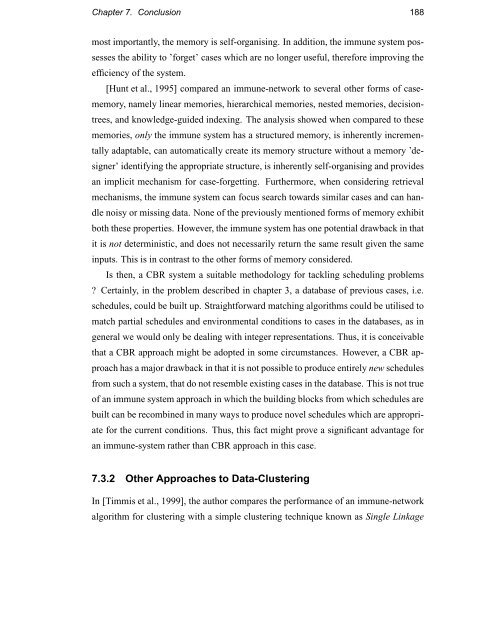Immunology as a Metaphor for Computational ... - Napier University
Immunology as a Metaphor for Computational ... - Napier University
Immunology as a Metaphor for Computational ... - Napier University
You also want an ePaper? Increase the reach of your titles
YUMPU automatically turns print PDFs into web optimized ePapers that Google loves.
Chapter 7. Conclusion 188most importantly, the memory is self-organising. In addition, the immune system possessesthe ability to ’<strong>for</strong>get’ c<strong>as</strong>es which are no longer useful, there<strong>for</strong>e improving theefficiency of the system.[Hunt et al., 1995] compared an immune-network to several other <strong>for</strong>ms of c<strong>as</strong>ememory,namely linear memories, hierarchical memories, nested memories, decisiontrees,and knowledge-guided indexing. The analysis showed when compared to thesememories, only the immune system h<strong>as</strong> a structured memory, is inherently incrementallyadaptable, can automatically create its memory structure without a memory ’designer’identifying the appropriate structure, is inherently self-organising and providesan implicit mechanism <strong>for</strong> c<strong>as</strong>e-<strong>for</strong>getting. Furthermore, when considering retrievalmechanisms, the immune system can focus search towards similar c<strong>as</strong>es and can handlenoisy or missing data. None of the previously mentioned <strong>for</strong>ms of memory exhibitboth these properties. However, the immune system h<strong>as</strong> one potential drawback in thatit is not deterministic, and does not necessarily return the same result given the sameinputs. This is in contr<strong>as</strong>t to the other <strong>for</strong>ms of memory considered.Is then, a CBR system a suitable methodology <strong>for</strong> tackling scheduling problems? Certainly, in the problem described in chapter 3, a datab<strong>as</strong>e of previous c<strong>as</strong>es, i.e.schedules, could be built up. Straight<strong>for</strong>ward matching algorithms could be utilised tomatch partial schedules and environmental conditions to c<strong>as</strong>es in the datab<strong>as</strong>es, <strong>as</strong> ingeneral we would only be dealing with integer representations. Thus, it is conceivablethat a CBR approach might be adopted in some circumstances. However, a CBR approachh<strong>as</strong> a major drawback in that it is not possible to produce entirely new schedulesfrom such a system, that do not resemble existing c<strong>as</strong>es in the datab<strong>as</strong>e. This is not trueof an immune system approach in which the building blocks from which schedules arebuilt can be recombined in many ways to produce novel schedules which are appropriate<strong>for</strong> the current conditions. Thus, this fact might prove a significant advantage <strong>for</strong>an immune-system rather than CBR approach in this c<strong>as</strong>e.7.3.2 Other Approaches to Data-ClusteringIn [Timmis et al., 1999], the author compares the per<strong>for</strong>mance of an immune-networkalgorithm <strong>for</strong> clustering with a simple clustering technique known <strong>as</strong> Single Linkage









![Unit 5. Switches and VLANs [PDF]](https://img.yumpu.com/34422504/1/184x260/unit-5-switches-and-vlans-pdf.jpg?quality=85)






